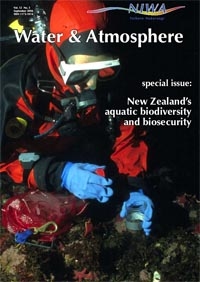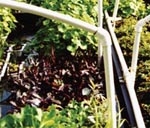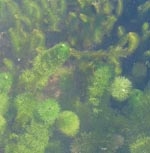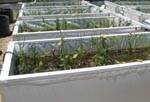PDF of this article (335 KB)

Paul Champion
Potential pests could be living in your aquarium or garden pond.
A significant threat to the biosecurity of New Zealand’s freshwater habitats comes from plants that have been intentionally introduced. Over 70 freshwater aquatic plants introduced into New Zealand have now naturalised here and many have become problem weeds, with most New Zealand lakes, rivers and streams affected by at least one of these species. Impacts are significant, including reduction in indigenous biodiversity and economic losses. Over 75% of these weeds were deliberately introduced as plants suitable for the aquarium or ornamental pond trade, with several other species also deliberately introduced as fodder or culinary plants. The deliberate nature of introductions is probably not surprising given the geographic isolation of New Zealand and the barriers to accidental or natural spread of freshwater plants. As the aquarium or ornamental pond trade has served as the source of such weeds in the past, it’s reasonable to assume that there may be other potential weeds still out there waiting to naturalise.
Results of our survey

A recent NIWA survey of aquatic plants within the aquarium and nursery trade discovered over 180 aquatic plants that have not yet naturalised in New Zealand. The majority of these are tropical species that are unlikely to survive unaided in our climate, however 73 of these species are elsewhere considered to be weeds. The most recent potential weed species confirmed in New Zealand are flowering rush (Butomus umbellatus), greater reed mace (Typha latifolia) and an arrowhead (Sagittaria sagittifolia), which has already naturalised at one site. NIWA scientists have now expanded their search for other potential aquatic weeds within the collections of hobby aquarium and pond keepers. Another alarming finding of this survey was that 65 plant species were not previously recorded as present within New Zealand, or evaluated for entry via the MAF Biosecurity database. These plants have either been imported prior to restrictions imposed in 1976, or have entered since then, but have not been declared to border control authorities. Many of the plants were not known to be within the aquarium and nursery trade prior to the 1980s, so their entry must have been by illegal means.
Aquatic Weed Risk Assessment Model
NIWA has developed a model to evaluate the potential weed risk of aquatic plants. The key variables evaluated in the model are invasiveness or ability to establish and displace other plants, potential geographic distribution, and extent of potential impacts. Invasive attributes include habitat versatility (tolerance of ranges of temperature, salinity, substrate, flow and water depth), competitive ability compared with other species, and effective dispersal measured as a combination of reproductive output and mechanisms of spread. Potential distribution depends on availability of suitable habitat. Impacts include damage to natural ecosystems, changes to biodiversity, obstruction of water uses, and resistance to management activities.
This model has been used by authorities to decide which aquatic plants should be managed and a total of 35 aquatic plants are now designated unwanted organisms (preventing their importation and sale) and listed in the National Pest Plant Accord. This list includes several of the world’s worst aquatic weeds which have not yet arrived here, including Eurasian milfoil and water chestnut.
Recent experimental work
Unfortunately the information required to assess potential weeds using the Aquatic Weed Risk Assessment Model is not always available, so NIWA is currently testing the weed potential of some of our aquarium and pond plants (see panels below). These experiments add to our understanding of the invasive behaviour of our aquatic “weeds in waiting” and provide useful information to assess whether they are suitable for cultivation. Another NIWA project involves selecting and promoting alternative plants (which do not have the same weedy traits) for cultivation. These actions should significantly reduce the risk of naturalisation of new aquatic weeds and thus prevent their impacts on our waterways.

Testing potential weediness
To investigate their potential weediness under New Zealand conditions, a number of candidate species were experimentally evaluated by growing them in competition with known weeds and New Zealand natives. Where a species has yet to naturalise, this experimental approach allows us to quantify weed potential without threatening unimpacted natural environments. If a candidate displaces or severely reduces a competitor species, it would indicate significant weed potential. Experiments were run for 18 months, assessing plant performance (cover and height) throughout this time and measuring the biomass of each species at the end of this time. None of the species evaluated to date – Hygrophila polysperma, Hydrocotyle verticillata, Cabomba caroliniana and Saururus cernuus – had significant impact on either native or other introduced plants under experimental conditions.


Testing temperature tolerance
To evaluate the influence of temperature on invasiveness of 12 emergent plants (those with shoots above water), joint NIWA/Auckland University PhD student David Burnett has designed a set of tanks to compare growth under the same environmental conditions, with the exception of temperature. Tanks with temperatures that fluctuate 2, 4 and 6˚C above and below ambient temperature allow the assessment of plant performance. David monitors growth parameters such as stem number, flowering and fruiting period, height, and leaf area index. This research will assist in predicting potential plant distribution in New Zealand and invasive potential in different parts of this country.
Paul Champion is based at NIWA in Hamilton.
Further reading
Ministry of Agriculture and Forestry. (2001). National Pest Plant Accord.
